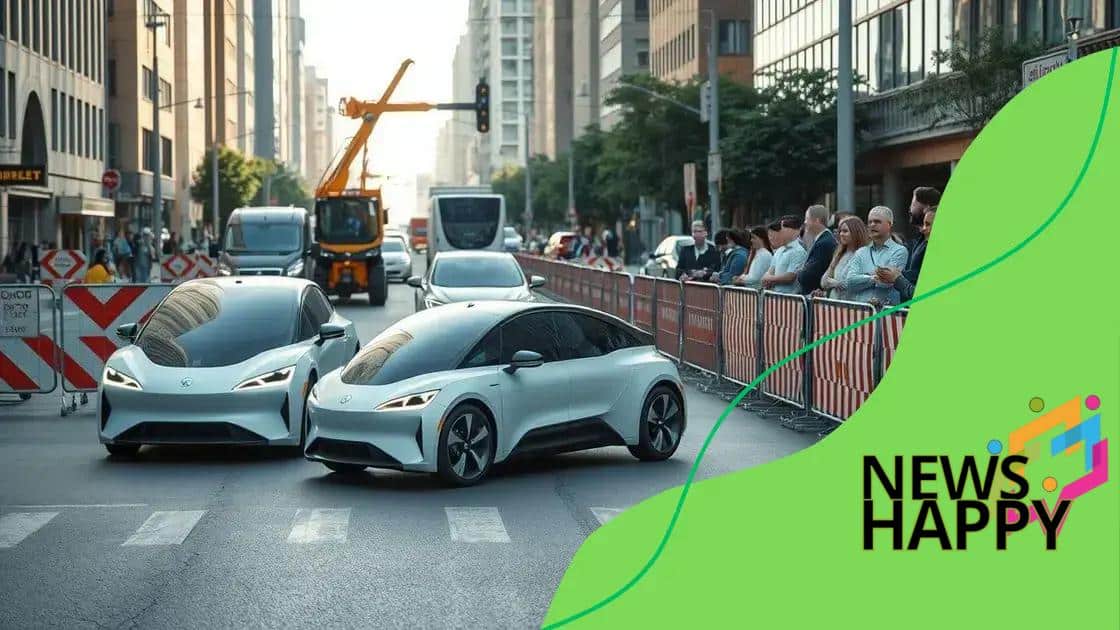The rise of autonomous electric vehicles in public transportation

Anúncios
The rise of autonomous electric vehicles in public transportation enhances efficiency, safety, and sustainability, while addressing challenges like regulatory hurdles and public acceptance.
The rise of autonomous electric vehicles in public transportation is reshaping how we think about mobility in our cities. Have you ever imagined a bus that drives itself? Let’s dive into the exciting world of self-driving transit solutions and their implications for our daily commutes.
Anúncios
Understanding autonomous electric vehicles
Understanding autonomous electric vehicles can be exciting and a bit complex. These vehicles are designed to drive themselves, which means they can transport passengers without human input. This innovation not only reflects advancements in technology but also aims to improve safety and efficiency on the roads.
What Makes Them Autonomous?
Autonomous vehicles use a variety of technologies to navigate. They employ sensors like cameras, radar, and lidar to detect their surroundings. These sensors gather data about the environment, which is processed to make real-time decisions.
Key Technologies
- Artificial Intelligence: Helps vehicles understand and learn from their environment.
- Machine Learning: Enables vehicles to improve their driving over time through experience.
- GPS Technology: Provides location information for accurate routing.
- V2X Communication: Allows vehicles to communicate with other vehicles and infrastructure.
Each of these technologies plays a crucial role in ensuring that autonomous electric vehicles can operate safely and efficiently. They must be able to recognize traffic signals, pedestrians, and obstacles in their path.
Anúncios
As cities grow, the need for efficient public transportation becomes more pressing. Autonomous electric vehicles can offer a cleaner alternative, reducing emissions and reliance on fossil fuels. They also promise to make transit more accessible to everyone.
Benefits of Autonomous Electric Vehicles
These vehicles offer several advantages:
- Increased Safety: With improved technology, accidents caused by human error could be significantly reduced.
- Cost Efficiency: Lower operational costs may lead to reduced fares for passengers.
- Accessibility: Autonomous vehicles can provide transportation options for individuals who cannot drive.
In conclusion, understanding autonomous electric vehicles highlights their potential to reshape transportation. With continuous advancements in technology, these vehicles could soon become commonplace, transforming our daily commutes and urban landscapes.
Benefits for public transportation
The benefits for public transportation brought by autonomous electric vehicles are numerous and significant. These innovative vehicles promise to enhance the efficiency, safety, and overall experience of public transit systems. Let’s explore some of the key advantages.
Improved Safety
One of the most compelling benefits is the potential for enhanced safety. With advanced sensors and AI, autonomous electric vehicles can anticipate dangers and react faster than human drivers. This capability can lead to a marked decrease in accidents.
Cost Reduction
These vehicles can help reduce operational costs in the long run. Without the need for a human driver, transit agencies can save on labor expenses. Additionally, electric vehicles typically have lower maintenance costs compared to traditional gasoline-powered buses.
- Lower Fuel Costs: Electric vehicles are more efficient and have reduced fueling expenses.
- Maintenance Savings: Fewer moving parts mean less wear and tear.
- Reduced Insurance Costs: Fewer accidents can lead to lower premiums.
By incorporating autonomous electric vehicles, public transportation systems can allocate funds more effectively, improving infrastructure and services.
Environmental Benefits
Autonomous electric vehicles also contribute positively to the environment. They produce zero emissions, making them an excellent choice for reducing urban pollution. By transitioning to electric fleets, cities can significantly lower their carbon footprint.
Moreover, the deployment of these vehicles can encourage more people to use public transit, which helps to decrease the number of private cars on the road. This transition not only eases traffic congestion but also enhances air quality in urban areas.
Increased Accessibility
Another compelling advantage is the potential for increased accessibility. Autonomous electric vehicles can provide reliable transportation options for people with disabilities, seniors, and those without access to a traditional vehicle. They aim to create a more inclusive public transit system.
With their capacity to operate without a human driver, these vehicles can ensure that all individuals can travel conveniently and safely.
Challenges in implementation

Implementing autonomous electric vehicles in public transportation presents several challenges that must be addressed. These vehicles have the potential to revolutionize how we move around cities, yet significant hurdles remain in their deployment.
Regulatory Hurdles
One major challenge is navigating the regulatory landscape. Governments need to establish clear guidelines and safety standards for self-driving vehicles. This process can be slow, often delaying the integration of autonomous electric vehicles into existing transit systems.
Public Acceptance
Another critical factor is public acceptance. Many people might feel uneasy about riding in a vehicle without a human driver. Building trust is essential, and this can require extensive public education efforts. It’s important for stakeholders to communicate how these vehicles work and their safety record.
- Transparency: Providing information about technology and safety measures.
- Public Engagement: Involving communities in discussions about implementation.
- Demonstration Projects: Offering pilot programs to familiarize the public.
Additionally, outreach programs can help address concerns and collect feedback from future riders to improve services.
Technological Limitations
The technology behind autonomous electric vehicles is continually evolving, but there are still limitations. These vehicles rely on sensors and software to operate safely. In complex urban environments, challenges such as extreme weather conditions and construction zones can impact their performance.
Moreover, an efficient system of communication between vehicles and infrastructure is necessary for proper operation. This presents a technical barrier that requires significant investment to develop.
Infrastructure Requirements
The current infrastructure may need upgrades to accommodate these vehicles. Charging stations, dedicated lanes, and smart traffic management systems are just a few elements that play a role in successful implementation.
Funding for such upgrades can be a challenge, as municipalities often have limited budgets. Careful planning and investment are required to ensure a seamless transition to a more advanced public transportation system.
Impact on urban mobility
The impact of autonomous electric vehicles on urban mobility is poised to be significant. These vehicles can change the way people navigate cities, making commuting more efficient and accessible for everyone.
Reduced Traffic Congestion
One of the primary effects is the potential reduction in traffic congestion. As more people choose public transportation options like autonomous electric vehicles, the number of private cars on the roads could decrease. This shift could lead to smoother traffic flow and shorter travel times.
Flexible Transportation Options
These vehicles can also offer more flexible transportation solutions. For instance, they can operate on demand, picking up passengers when and where they need it. This flexibility can make public transit more appealing, especially for those who find traditional bus schedules inconvenient.
- On-Demand Services: Passengers can request rides via an app, similar to rideshare services.
- Last-Mile Connectivity: Autonomous vehicles can connect users to public transit hubs.
- Shared Mobility: Carpooling features can lower costs and environmental impact.
Greater flexibility can encourage people to leave their cars at home, further alleviating street congestion.
Environmental Sustainability
The adoption of autonomous electric vehicles contributes positively to environmental sustainability as well. With zero tailpipe emissions, they can significantly reduce air pollution in urban areas. Cleaner air improves public health and makes cities more livable.
Moreover, these vehicles can operate more efficiently, optimizing routes and reducing energy consumption. In the long run, this can lead to greener cities where public transport plays a central role in sustainable development.
Inclusivity in Transportation
Another key impact is the potential for increased inclusivity in urban mobility. Autonomous electric vehicles can provide accessible transportation options for individuals who may struggle with traditional transit, including the elderly and those with disabilities.
This enhanced accessibility ensures that everyone can benefit from improved mobility options, creating a more equitable urban landscape.
Future trends in public transit
Future trends in public transit are being heavily influenced by advancements in technology and changing societal expectations. The integration of autonomous electric vehicles marks one of the most significant shifts in how we think about urban mobility.
Smart Transportation Systems
One major trend is the rise of smart transportation systems. These systems utilize data analytics, IoT devices, and AI to improve transit efficiency. For instance, sensors on vehicles can collect data on traffic patterns, helping transit agencies optimize routes in real-time.
Integration with Mobility as a Service (MaaS)
Another trend is the integration of Mobility as a Service (MaaS) platforms. These platforms combine various forms of transportation into one easy-to-use service. Users can seamlessly plan, book, and pay for their journeys using a single app. This integration can include:
- Buses and Trains: Users can schedule rides on public transit.
- Bikes and Scooters: Availability of shared bikes and scooters for last-mile connectivity.
- Rideshare Options: Easy access to rideshare services to fill transportation gaps.
This makes public transit more attractive and user-friendly, encouraging more people to opt for shared mobility solutions.
Sustainability and Green Initiatives
As cities become increasingly aware of environmental issues, sustainability in public transit is also becoming a priority. Autonomous electric vehicles play a key role in this shift. By reducing emissions and incorporating renewable energy sources, they contribute to greener urban environments.
Furthermore, many transit agencies are exploring the use of solar panels on vehicles and transit facilities to offset energy consumption. Cities are looking to design more eco-friendly infrastructure to support public transportation.
User-Centric Design
Future public transit systems will increasingly focus on user-centric design. This means creating an inclusive environment that meets the diverse needs of all passengers. Features such as real-time tracking, comfortable seating, and accessibility options for individuals with disabilities will be prioritized.
As mobility continues to evolve, the goal is to create public transit that is not only efficient but also welcoming and easy to navigate.
FAQ – Frequently Asked Questions about Autonomous Electric Vehicles in Public Transportation
What are autonomous electric vehicles?
Autonomous electric vehicles are self-driving vehicles that operate without human input, using advanced technology to navigate roads.
How do autonomous electric vehicles benefit public transportation?
They improve safety, reduce operational costs, and are environmentally friendly, offering a sustainable alternative to traditional vehicles.
What challenges do cities face when implementing these vehicles?
Cities must address regulatory hurdles, public acceptance, and technological limitations to effectively integrate autonomous electric vehicles.
What role does public engagement play in this transition?
Public engagement is crucial for building trust, educating the community, and ensuring that the new systems meet the needs of all residents.





